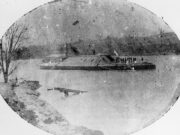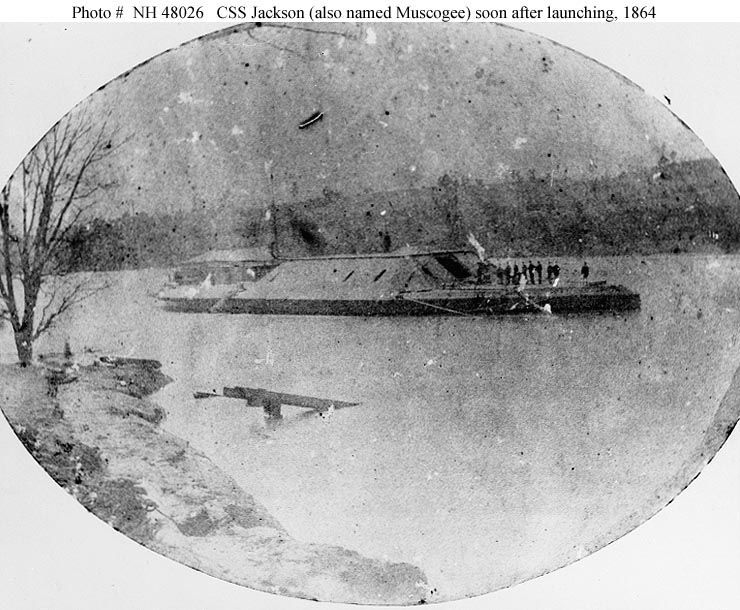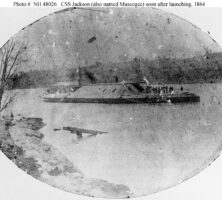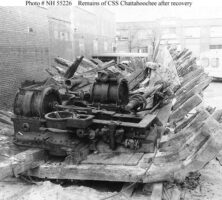As part of the Union naval strategy to blockade Southern ports during the Civil War (1861-65), the U.S. Navy closed access to the Chattahoochee River system at Apalachicola, Florida, on June 11, 1861, and maintained its coastal presence there for the remainder of the war. In response, the Confederate navy built both a steam-powered gunship, the CSS Chattahoochee, and an ironclad, the CSS Jackson (also known as CSS Muscogee), to descend to open seas and break the blockade. However, the shallow coastline, the Chattahoochee’s unpredictable flow, and a series of management and engineering mishaps prevented the enemies from engaging in battle throughout the course of the war. The Union navy settled into a long, dull presence on the coast, while Confederate officers and engineers upriver struggled to build a ship that could break the blockade and restore trade to the region.
Blockade’s Impact
Within a year of the Union navy’s arrival, military and civilian life on the lower Chattahoochee ground to a frustrating standstill while engineers, officers, politicians, and businessmen upriver struggled to convert industrial strength into naval might for the Confederacy. The strategic importance of the blockade was threefold: Columbus, Georgia, one of the most industrialized cities in the Deep South, sat at the head of the navigable portion of the Chattahoochee River; Apalachicola, a major shipping center, lay on the coast; and a fertile cotton-growing region, the lifeblood of the Southern economy, sprawled between the two.
Apalachicola became a ghost of its antebellum self as farmers and industrialists to the north began using the railroad system to ship their goods. Columbus, meanwhile, expanded its industrial production and began manufacturing many of the Confederate navy’s steam engines. The overall effect of the blockade was to swiftly shift economic and military importance elsewhere for the remainder of the war.
Although the U.S. Navy never ascended the Chattahoochee River to attack the Naval Iron Works at Columbus, it held the blockade of Apalachicola successfully, thereby circumscribing Confederate movement in and out of the port. Despite this success, seamen serving in the blockade experienced the desperate boredom of their duty and recognized the marginality of their contribution to the war effort. As the war dragged on, the Union ships stationed off Apalachicola became less likely to chase blockade runners and more likely to take on refugees, Confederate deserters, and fugitives from slavery looking for transport out of the area.
Construction on the Chattahoochee
While the Union navy blockaded the port of Apalachicola, rumors about the construction of a new Confederate gunboat began to filter downriver. In the fall of 1861, Confederate naval officers and the chief engineer of the Columbus Naval Iron Works contracted with a private firm based in Saffold, Georgia, 175 miles south of Columbus and 140 miles upriver from Apalachicola, to build a 130-foot-long gunboat in four months. In theory, the CSS Chattahoochee was to be both riverboat and ocean-sailing craft. Upon its completion, the Confederate navy hoped to steam it downriver, break the blockade, and open the port of Apalachicola for the return of supply ships and trade to the region.

Courtesy of U.S. Naval Historical Center
However, disaster and mishap struck the construction and eventual launch of the gunboat at every turn, highlighting the strong disadvantages that the Confederacy held in building and managing a navy under wartime conditions and depletions. After many delays, the long-awaited launch of the Chattahoochee took place in February 1863, but the vessel ran aground on its first day on the river and seriously damaged its hull. By the time the steamer was again ready for service, the Confederate army, feeling impatient and vulnerable to attack, had sunk obstructions into the Apalachicola River, destroying any hopes that the Chattahoochee’s officers held of engaging the Union force at sea. By the spring of 1863 the Confederate navy had stationed the gunboat, now no more than a glorified floating battery, above the obstructions. On May 27, 1863, the boilers of the Chattahoochee exploded due to the crew’s inexperience, killing several sailors, maiming others, and effectively destroying the ship for the remainder of the war.
During the war, the Columbus Naval Iron Works also supplied engine machinery for many of the Confederacy’s ironclads. On the Chattahoochee River, the Confederacy commissioned the construction of the CSS Jackson in 1862. This ship also faced a series of setbacks and delays that prevented it from ever reaching the Union blockade. Despite a scarcity of resources, the Jackson was completed in less than a year. However, inconsistent river levels prevented its initial launch, and an ordered redesign of the paddle system cost the crew any opportunity to engage the blockaders at the mouth of the Apalachicola River.
Wilson’s Raid and the Sack of Columbus
As the war’s end approached, the Union command sent a cavalry unit of 13,500 men, under the command of Major General James H. Wilson, to capture and occupy the Chattahoochee River Valley of Alabama and Georgia. Although historians debate the rationale behind this venture, the region had survived the war without any major battles and presumably could have served as the home base of a desperate last stand.
Launching the campaign from Tennessee, Wilson’s raiders swept swiftly through the poorly defended cities of Alabama, and on Easter Sunday, April 16, 1865, the cavalry crossed the Broadnax Street Bridge from Girard, Alabama, into Columbus in the dark of night. By morning, the Union soldiers had captured the city and begun laying waste to its industrial capabilities, including the Columbus Naval Iron Works. Wilson’s men set the Jackson aflame and adrift on the river, where it burned for nearly two weeks before sinking; navy yard workers did the same to the Chattahoochee to prevent it from falling into enemy hands. In the early 1960s both ships were raised from the riverbed. Today, visitors to the National Civil War Naval Museum at Port Columbus can view what remains of both crafts.







